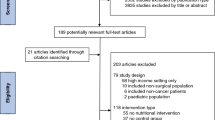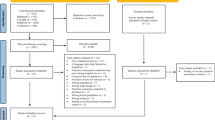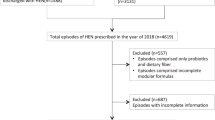Abstract
Objective:
A health economic analysis was performed to assess the cost-effectiveness of oral nutritional supplements (ONS), being a medical nutrition product, in the Netherlands.
Methods:
This analysis is based on a comparison of the use of ONS versus ‘no use’ of ONS in patients undergoing abdominal surgery. The costs and benefits of the two treatment strategies were assessed using a linear decision analytical model reflecting treatment patterns and outcomes in abdominal surgery. The incremental cost difference was based on costs associated with ONS and hospitalization. Clinical probabilities and resource utilization were based on clinical trials and published literature; cost data were derived from official price tariffs.
Results:
The use of ONS reduces the costs with a € 252 (7.6%) cost saving per patient. The hospitalization costs reduce from € 3,318 to € 3,044 per patient, which is a 8.3% cost saving and corresponds with 0.72 days reduction in length of stay. The use of ONS would lead to an annual cost saving of a minimum of € 40.4 million per year. Sensitivity analyses showed that the use of ONS remains cost saving compared with ‘no use’ of ONS. A threshold analysis on the length of stay shows that at 0.64 days, the use of ONS is still cost-effective, which is an unrealistic value.
Conclusions:
This analysis shows that the use of medical nutrition, ONS in this case, is a cost-effective treatment in the Netherlands and is dominant over standard care without medical nutrition: it leads to cost savings and a higher effectiveness.
This is a preview of subscription content, access via your institution
Access options
Subscribe to this journal
Receive 12 print issues and online access
$259.00 per year
only $21.58 per issue
Buy this article
- Purchase on Springer Link
- Instant access to full article PDF
Prices may be subject to local taxes which are calculated during checkout


Similar content being viewed by others
References
ASPEN (2002). Guidelines for the use of parenteral and enteral nutrition in adult and pediatric patients. J Parenter Enteral Nutr 26 (Suppl), 1SA–138SA.
Elia M, Stratton R, Russel C, Green C, Pang F (2005a). The cost of disease related malnutrition in the UK and economic considerations for the use of oral nutritional supplements in adults. Health Economic Report on Malnutrition in the UK. BAPEN.
Elia M, Zellipour L, Stratton RJ (2005b). To screen or not to screen for adult malnutrition? Clin Nutr 24, 867–884.
FSSPEN French Speaking Society for Parenteral & Enteral Nutrition (1996). Perioperative artificial nutrition in elective adult surgery. Clin Nutr 15, 223–229.
Gariballa S, Forster S, Walters S, Powers H (2006). A randomized double-blind placebo-controlled trial of nutritional supplementation during acute illness. Am J Med 119, 693–699.
Halfens RJG, Janssen MAP, Meijers JMM (2006). Ondervoeding. In: Rapportage resultaten Landelijke prevalentiemeting zorgproblemen 2006 Universiteit Maastricht Zorgwetenschappen sectie Verplegingswetenschap Universitaire pers Maastricht: Maastricht, pp 79–101.
Halfens RJG, Meijers JMM, Neyens JCL, Offermans MPJ (2007). Ondervoeding. In: Rapportage resultaten. Landelijke prevalentiemeting zorgproblemen 2007, Universiteit Maastricht Onderzoeksinstituut Caphri, Department of Health Care and Nursing Sciences Universitaire pers Maastricht: Maastrichtm, pp 81–108.
Kruizenga HM, Wierdsma NJ, van Bokhorst -de van der Schueren MAE, Hollander HJ, Jonkers-Schuitema CF, van der Heijden E et al. (2003). Screening of nutritional status in The Netherlands. Clin Nutr 22, 147–152.
Maessen J, Dejong CHD, Hausel J, Nygren J, Lassen K, Andersen J et al. (2007). A protocol is not enough to implement an enhanced recovery programme for colorectal resection. Br J Surg 94, 224–231.
Martyn CN, Winter PD, Coles SJ, Edington J (1998). Effect of nutritional status on use of health care resources by patients with chronic disease living in the community. Clin Nutr 17, 119–123.
McClave SA, Snider HL, Spain DA (1999). Preoperative issues in clinical nutrition. CHEST 115, 64S–70S.
Naber TH, Schermer T, de Bree A, Nusteling K, Eggink L, Kruimel JW et al. (1997). Prevalence of malnutrition in nonsurgical hospitalized patients and its association with disease complications. Am J Clin Nutr 66, 1232–1239.
Nuijten MJ (1998). The selection of data sources for use in modelling studies. Pharmacoeconomics 13, 305–316.
Oostenbrink JB, Bouwmans CAM, Koopmanschap MA, Rutten FFH (2004). Handleiding voor kostenonderzoek, Geactualiseerde versie 2004 CVZ: Diemen.
Potter JM (2001). Oral supplements in the elderly. Curr Opin Clin Nutr Metab Care 4, 21–28.
Prismant (2003). Data on number of hospitalisations and length of stay.
Stratton RJ (2005). Elucidating effective ways to identify and treat malnutrition. Proc Nutr Soc 64, 305–311.
Stratton RJ, Elia M (2007). Who benefits from nutritional support: what is the evidence? Eur J Gastroenterol Hepatol 19, 353–358.
Stratton RJ, Ek AC, Engfer M, Moore Z, Rigby P, Wolfe R et al. (2005). Enteral nutritional support in prevention and treatment of pressure ulcers: a systematic review and meta-analysis. Ageing Res Rev 4, 422–450.
Stratton RJ, Green CJ, Elia M (2003). Disease-related malnutrition: an evidence-based approach to treatment. CABI Publishing: Oxford.
Tan SS, Koopmanschap M (2007). The cost of disease related malnutrition and the cost-effectiveness of nutrition interventions: a feasibility study for the Netherlands. Data on file.
Weinstein MC, Fineberg HV (1980). Clinical decision analysis. WB Saunders Co: Philadelphia, Pa, pp 228–265.
Richtlijn Perioperatief voedingsbeleid (2007). Kwaliteitsinstituut voor de Gezondheidszorg CBO, http://www.cbo.nl.
ACHTERGRONDINFORMATIE (2008). Implementatie van vroege herkenning & behandeling van ondervoeding in de kliniek en op de polikliniek in Nederlandse ziekenhuizen. www.snellerbeter.nl/fileadmin/snellerbeter/documenten/Ondervoeding/19projectplan_maasziekenhuispantein.doc, http://www.snellerbeter.nl (accessed 12 May 2008).
Author information
Authors and Affiliations
Corresponding author
Ethics declarations
Competing interests
The publication of the study results was not contingent on the sponsor's approval; this research was funded by the Dutch Industry of Children and Dietary Nutrition (VNFKD) and Dr Mark Nuijten has served as a consultant and was paid to conduct the analyses presented in this article.
Rights and permissions
About this article
Cite this article
Freijer, K., Nuijten, M. Analysis of the health economic impact of medical nutrition in the Netherlands. Eur J Clin Nutr 64, 1229–1234 (2010). https://doi.org/10.1038/ejcn.2010.147
Received:
Revised:
Accepted:
Published:
Issue Date:
DOI: https://doi.org/10.1038/ejcn.2010.147
Keywords
This article is cited by
-
Economic evaluation for protein and energy supplementation in adults: opportunities to strengthen the evidence
European Journal of Clinical Nutrition (2013)



